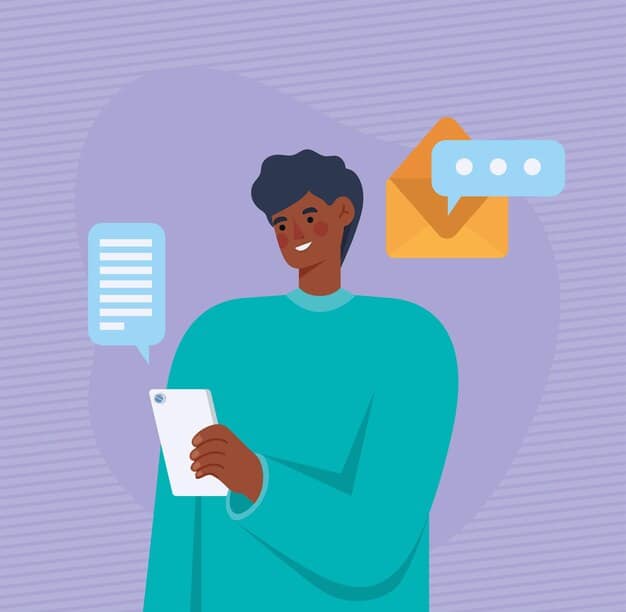Email Communication in the Age of AI: Boost Response Rates by 15%

Email communication in the age of AI requires adapting to new technologies and potential misunderstandings; following four key rules can enhance clarity and boost response rates by 15%.
Navigating email communication in the age of AI: 4 rules to avoid misunderstandings and boost response rates by 15% can be challenging, but mastering it ensures effective interactions and improved outcomes.
AI’s Impact on Email Communication
Artificial intelligence is rapidly changing how we communicate via email. Understanding its influence is crucial for maintaining clear and effective interactions.
AI-powered tools are becoming increasingly common in email platforms. These tools offer features like automated writing assistance, spam filtering, and predictive text.
The Rise of AI Writing Assistants
AI writing assistants analyze your text in real-time, suggesting improvements to grammar, vocabulary, and style. These tools aim to make your emails more polished and professional.
AI-Driven Spam Filters
AI algorithms now power advanced spam filters, learning from vast datasets to identify and block unwanted emails. This results in a cleaner inbox but also carries the risk of legitimate emails being misclassified.
Effective email communication in the age of AI means adapting to these changes and leveraging AI’s benefits without sacrificing clarity or personal touch.
- Benefits: Streamlines writing, improves grammar, reduces spam.
- Risks: Over-reliance on AI, potential for misinterpretation, filtering errors.
- Strategies: Review AI suggestions carefully, personalize messages, monitor spam folders.

In conclusion, AI’s impact on email is pervasive, offering both advantages and challenges. By understanding these effects, we can navigate the digital landscape more effectively.
Rule 1: Prioritize Clarity Over Cleverness
In the age of AI, clarity in your emails is more important than ever. It ensures your message is understood as intended, reducing the chance of misunderstandings.
AI can sometimes misinterpret nuances or subtle hints. Therefore, it’s essential to make your message as straightforward and unambiguous as possible.
Avoid Ambiguity
Ambiguous language can confuse both humans and AI. Use clear and direct phrasing to convey your message effectively.
Use Simple Language
Opt for simple, easy-to-understand words instead of complex jargon. This makes your email more accessible to a wider audience.
By prioritizing clarity over cleverness, you minimize the potential for misinterpretation and ensure your message is received as intended.
- Be direct: State your purpose clearly.
- Provide context: Offer sufficient background information.
- Use examples: Illustrate your points with concrete examples.
Remember, the goal is to communicate effectively, not to impress with your vocabulary. Simplicity and clarity will always win.
Rule 2: Humanize Your Emails
In an era dominated by AI, adding a human touch to your emails is critical. It builds rapport, fosters trust, and makes your communication more engaging.
Personalized emails stand out in a sea of automated messages. They show that you value the recipient as an individual.
Personalize Your Greetings
Use the recipient’s name instead of generic greetings like “Dear Sir/Madam.” A personalized greeting immediately establishes a connection.
Share Personal Anecdotes
Include brief, relevant personal anecdotes to make your email more relatable. This humanizes your message and makes you more approachable.
By humanizing your emails, you create a more meaningful connection with the recipient, increasing the likelihood of a positive response.
- Use the recipient’s name.
- Reference past interactions.
- Share relevant personal stories.
Don’t be afraid to show your personality. Authenticity resonates with people, creating a stronger bond.
Rule 3: Be Mindful of Tone and Emotion
Emails lack the visual and auditory cues of face-to-face conversations, making tone and emotion crucial. Misunderstandings can easily arise if your tone is misinterpreted.
AI algorithms can sometimes struggle to detect subtle emotional cues. Therefore, it’s important to be deliberate in your tone.
Use Positive Language
Frame your message using positive language. Instead of saying “This is not acceptable,” try “Let’s explore how we can improve this.”
Avoid Sarcasm
Sarcasm rarely translates well in emails. It can easily be misinterpreted as criticism or negativity.
Being mindful of tone and emotion can prevent misunderstandings and foster a more positive and productive communication environment.
- Read your email aloud before sending.
- Ask a colleague to review your message.
- Assume positive intent.

Remember, your words carry weight, especially in written form. Choose them carefully to convey the right message.
Rule 4: Proofread and Test Your Emails
In the fast-paced digital world, it’s easy to rush through emails. However, proofreading and testing are essential for ensuring accuracy and effectiveness.
Even with AI-powered grammar checkers, human review is still necessary. AI can miss certain errors or nuances.
Check for Grammatical Errors
Review your email for typos and grammatical mistakes. Errors can undermine your credibility and detract from your message.
Test Your Links
Ensure that all links in your email are working correctly. Broken links can frustrate recipients and defeat the purpose of your message.
By proofreading and testing your emails, you ensure that your message is error-free and delivers the intended impact.
- Use grammar checking tools.
- Click on all links to verify functionality.
- Send a test email to yourself.
A little extra effort can go a long way in ensuring your email is polished and professional.
Measuring the Impact: Boosting Response Rates by 15%
Implementing these four rules can significantly improve your email communication. One measurable outcome is a potential boost in response rates.
By following these guidelines, you can expect to see a noticeable increase in engagement and responsiveness from your recipients.
Track Your Response Rates
Monitor your email response rates before and after implementing these rules. This provides a clear measurement of their impact.
Gather Feedback
Solicit feedback from your recipients about your emails. This can provide valuable insights into what works and what doesn’t.
Measuring the impact of these rules can validate their effectiveness and provide motivation to continue refining your email communication approach.
- Use email analytics tools.
- Conduct A/B testing.
- Analyze customer feedback.
Remember, small changes can lead to big results. Consistent application of these principles can transform your email communication.
| Key Point | Brief Description |
|---|---|
| 📌 Clarity First | Prioritize clear, direct language to avoid AI misinterpretations. |
| 🙂 Human Touch | Personalize emails to build rapport and show you value the recipient. |
| 🎭 Tone Matters | Be mindful of tone and emotion to prevent misunderstandings. |
| ✅ Proofread | Always proofread emails to ensure accuracy and professionalism. |
Frequently Asked Questions
▼
Use straightforward language, avoid jargon, and provide clear context. Break down complex ideas into smaller, digestible parts. Visual aids like bullet points can also enhance clarity.
▼
Address recipients by name, reference past interactions, and share relevant personal anecdotes. Show genuine interest in their needs and perspectives. A handwritten sign-off can also add a personal touch.
▼
Use positive language, avoid sarcasm, and be mindful of your word choice. Read your email from the recipient’s perspective to anticipate potential misinterpretations. When in doubt, err on the side of caution.
▼
AI grammar tools are helpful, but they aren’t perfect. They may miss subtle errors or context-specific nuances. Human review ensures accuracy and polished presentation, enhancing your credibility.
▼
Track your response rates before and after implementing these rules. Use email analytics to monitor engagement metrics. Gather feedback from recipients about their experience with your emails. A/B test different approaches.
Conclusion
Mastering email communication in the age of AI: 4 rules to avoid misunderstandings and boost response rates by 15% requires a blend of human insight and technological awareness. By prioritizing clarity, personalizing your messages, being mindful of tone, and diligently proofreading, you can navigate the complexities of this new era and achieve greater success in your email interactions.


